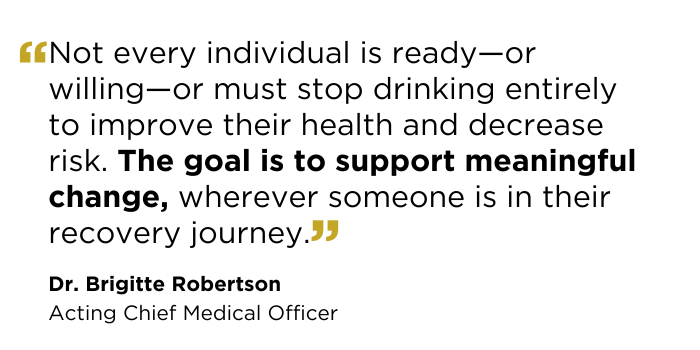Spotlight Series
Stay updated with insights from Adial’s executives on the latest company news and key developments in addiction research.
View All Spotlight SeriesLess Can Be More: Rethinking What Alcohol Recovery Looks Like
July 7, 2025
What if recovery from alcohol use disorder didn’t have to mean quitting cold turkey?
Brigitte Roberston, MD, Acting Chief Medical Officer
New perspectives and emerging treatment options are challenging the long-standing belief that recovery must be all or nothing. Instead, a growing number of clinicians and patients are exploring how drinking less, not necessarily stopping entirely, can lead to meaningful improvements in health, quality of life, and long-term outcomes.
Reducing alcohol consumption has gained traction in recent years as a growing body of scientific literature has illuminated the negative health consequences of alcohol use. A greater understanding of alcohol’s effects on someone’s overall health has also brought forth a dialogue on the need to mitigate these negative consequences on an individual level in those attempting to recover from Alcohol Use Disorder (AUD).
According to the National Survey on Drug Use and Health (NSDUH), AUD affects nearly 30 million Americans. It is characterized by several features, including consumption of more alcohol than intended, unsuccessful attempts to reduce or limit alcohol consumption, cravings to use alcohol, and persistent alcohol use despite continual problems caused by alcohol consumption. AUD has no single cause and can be triggered by a variety of factors such as genetic predisposition, psychological trauma, sociological and environmental factors, among others. While total abstinence has long been the standard of treatment for AUD, it doesn’t work for everyone. Given the multiplex of factors that have been implicated in AUD, patients would benefit from a broader set of treatment options.
Redefining Recovery: It’s Not All or Nothing
The National Institute on Alcohol Abuse and Alcoholism (NIAAA) recently introduced a new definition of recovery, which recognizes it as a process in which individuals work toward both remission from AUD and reductions in heavy drinking. This new definition recognizes harm reduction and non-abstinent recovery outcomes. It also emphasizes improvements in physical and mental health, quality of life, and overall well-being as core indicators of progress.
The NIAAA’s updated definition of recovery comes at a time of growing interest by individuals who want to decrease their drinking and need new strategies and therapies to achieve their goals. The aim of harm reduction is to reduce or minimize negative effects related to substance use. The reality of treatment for AUD now is that many struggle to quit “cold turkey” and it often involves multiple attempts before achieving a sustainable state without alcohol.
Harm reduction takes into account the diverse and long-term nature of people’s relationship with alcohol and provides an avenue for people to gradually reduce their consumption. It also allows for personalized strategies and supports individuals in making other incremental, more manageable, healthier lifestyle choices. Flexible recovery options provide the opportunity to begin reducing the negative health consequences of excessive alcohol consumption, while at the same time improving someone’s quality of life safety, and well-being. Most importantly, they recognize the distinct and non-linear treatment paths individuals may experience.
Personalizing the Path to Recovery
 Given the social and cultural implications of alcohol consumption, reducing consumption to moderate or non-problematic levels may be a more realistic outcome for many. This is further reinforced by the social stigma often experienced by those who are actively seeking treatment. An open acknowledgment of sobriety when offered alcohol in social settings can often result in feelings of shame or embarrassment for the individual and can be met with unwanted assumptions about the individual’s prior history by others.
Given the social and cultural implications of alcohol consumption, reducing consumption to moderate or non-problematic levels may be a more realistic outcome for many. This is further reinforced by the social stigma often experienced by those who are actively seeking treatment. An open acknowledgment of sobriety when offered alcohol in social settings can often result in feelings of shame or embarrassment for the individual and can be met with unwanted assumptions about the individual’s prior history by others.
Non-abstinence-based treatment strategies aim to meet individuals where they are on their recovery journey by acknowledging that many may not be ready to seek total abstinence immediately. The goal is to focus on disrupting and stopping the “downward spiral” experienced by many struggling with excessive alcohol use that makes their lives unmanageable and negatively impacts their physical and emotional health.
Tailoring Treatment for Real-World Recovery
AUD is not a one-cause problem and therefore cannot be treated by one single solution. Given that addiction recovery is often a journey of ups and downs with attempts at recovery followed by periods of relapse, there is a need to develop a variety of approaches that can be applied at different stages of an individual’s path to recovery. By meeting people where they are on their journey to recovery, practitioners can work together with their patients to develop practical strategies that prioritize progress over perfection. The need for personalized treatment strategies based on individual circumstances is a critical component of removing the stigma associated with recovery. Treating missteps, relapses, and failed attempts as normal parts of the process and meeting these challenges with corresponding solutions can help keep patients on the path toward recovery despite setbacks. Adial Pharmaceuticals’ lead asset, AD04, is a genetically targeted, investigational therapy for the treatment of AUD. Unlike traditional treatments that focus on complete abstinence, AD04 is designed to help patients reduce their alcohol consumption to safer levels, aligning with a harm-reduction approach.
AD04 is being developed for individuals with specific genetic markers that may predict better treatment response. It works by blocking serotonin signaling in the brain, which plays a key role in cravings and alcohol consumption behaviors. In clinical studies, AD04 has shown potential in reducing heavy drinking episodes and helping patients achieve more sustainable, controlled alcohol use.
There is a critical need for the expansion of flexible recovery options in the treatment of alcohol use disorder, and AD04 may represent a viable option in this space. Recent years have seen the rise of harm reduction strategies for the treatment of opioid use disorder, such as clean needle programs, safe injection sites, the availability of fentanyl test strips, and the widespread availability of naloxone. Individuals struggling with AUD stand to reap similar benefits from harm reduction strategies like those that have supported recovery from opioid use disorder. Most importantly, there is a need for the continued research and development of new treatment strategies in the field of AUD. The existing therapeutic strategies are by no means exhaustive, and clinical practitioners and patients alike would greatly benefit from the addition of options, including AD04, in their recovery toolbox.
—–
Recovery from AUD isn’t always a straight line, and it doesn’t have to begin with perfection. By embracing harm reduction and supporting strategies that prioritize progress over abstinence alone, we open the door to more inclusive, effective care. Whether someone’s goal is to stop drinking entirely or to take meaningful steps toward drinking less, the path to recovery should reflect their needs and experience, not just an ideal.
![]()
